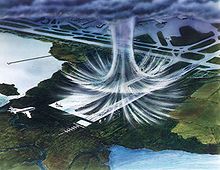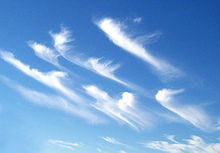Wind shear
![]()
The articles Wind shear and Shear wind overlap thematically. Information that you are looking for here may therefore also be found in the other article.
You are welcome to participate in the relevant redundancy discussion or to help directly to merge the articles or to better distinguish them from each other (→ Instructions).
![]()
This article explains the term wind shear; for other meanings, see Shear.
Wind shear, wind gradient or, more rarely, wind shear gradient is the difference in wind speed or direction over relatively short distances. In this context, wind shear refers to a wind whose speed or direction changes over a small geographical area. Strong wind shear can affect or even endanger the flight of aircraft. The shear line is the dividing line between the two air currents.
In the Earth's atmosphere, a distinction is made between vertical and horizontal wind shear. Horizontal wind shear occurs predominantly in the vicinity of tall structures, solitary trees and other vertical obstacles such as rocky outcrops. Vertical wind shear usually manifests itself as wind speed increasing in proportion to the distance from the earth's surface. The aerodynamic drag of the irregularities present on the surface slows down the winds near the surface.
Particularly pronounced shear effects occur in the vicinity of sharp-edged obstacles, as well as due to strong and gusty winds, such as in thunderstorms or jet streams.

Microburst with horizontally deflected shear winds on the ground

The formation of ice crystals in cirrus-uncinus clouds indicates strong wind shear with changing wind directions and speeds.

Downdrafts with accompanying virga form clouds that appear like aurora borealis in the eastern sky over the Mojave Desert at civil twilight.
Aircraft hazards
If an aircraft enters an area with wind shear, its movement adapts to the suddenly changed wind direction and strength only with a delay. This means that, depending on the wind direction, the wings initially experience additional lift or loss of lift due to increasing or decreasing airflow. Horizontal wind shear can occur at the gaps of hill chains and large rows of buildings, as well as being the result of a microburst (downdraft, or vertical wind shear), which is deflected into a horizontal direction (outflow) at ground level.
The driving force is large differences in air pressure, with the wind movement acting as a counterbalance. Near the ground, this weather phenomenon is a potential hazard both during take-off and landing of aircraft.
Examples
In December 1992, a McDonnell Douglas DC-10 on Martinair Flight 495 crashed due to wind shear at Faro. Another example is Lufthansa Flight 2904. The Airbus A320 was caught by wind shear during landing in Warsaw in September 1993 and subsequently taxied beyond the end of the rain-soaked runway. In August 1985, Delta Air Lines Flight 191 was struck by wind shear. This forced the Lockheed L-1011 TriStar to the ground and it moved across a highway, killing a motorist before exploding near the Dallas airport. 134 people died, only 29 survived. That flight sparked intense research into early detection of wind shear. They can now be detected in part by ground-based Doppler radar or LIDAR. On board, they can usually only be detected by the Ground Proximity Warning System (Mode 7) when flying in.
See also
- Shear layer
- Downburst
- Down gust
Search within the encyclopedia